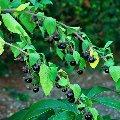This is the VOA Special English Agriculture Report.
Just because a plant looks nice does not mean you should eat it. Farmers learn this lesson tragically sometimes when their animals feed on wild plants. In fact, some of the nicest looking plants in the world are best enjoyed from a distance.
(MUSIC) A good example is belladonna. A "bella donna" -- like in the Stevie Nicks song -- is a beautiful woman in Italian. The plant is also beautiful. It has flowers like stars and shiny berries that start out green and turn purple to black. But every part of it is poisonous. Other names for belladonna include devil's herb and deadly nightshade. Yet just because something is dangerous does not always mean it is all bad. Belladonna and other poison plants have a long history of medical use.
The common or purple foxglove produces pretty flowers along a tall leafy stem called a spike. Foxglove can cause heart failure. Yet the plant is part of a group called Digitalis that is used in medicine to treat heart problems.
Weeds with names like coast fiddleneck, common cocklebur, low larkspur and common groundsel all present risks to people or animals. Recently there was news that a shopper at a market in northern Germany found small amounts of groundsel in bags of mixed salad. The average person would probably not have recognized it, but this person knew about poisonous plants.
Many people happily recognize oleander. The evergreen shrub produces beautiful flowers -- white, red, pink and other colors. But officials in Southern California say someone recently poisoned more than twenty show horses by mixing oleander in their feed. Local newspapers say the horses have recovered.
Amy Stewart is a best selling author of books about the good and bad in nature. She lives in Northern California and raises a poison garden of her own. Her newest book is called "Wicked Plants." So which plant does she consider the deadliest of all?
AMY STEWART: "Tobacco has killed more people than any other plant I could find. I mean, ninety million people have died because of tobacco." And that's the VOA Special English Agriculture Report, written by Jerilyn Watson with Faiza Elmasry. Transcripts and podcasts of our weekly reports are at voaspecialenglish.com. I'm Bob Doughty.

